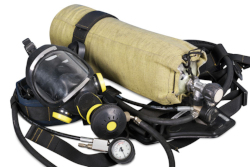Self-Contained Breathing Apparatus (SCBA)
The types of SCBAs and their relative advantages and disadvantages are discussed below.
Open-Circuit Entry-Escape SCBA
- Description: Supplies clean air to the wearer from a cylinder. Wearer exhales air directly to the atmosphere.
- Advantages: Operated in a positive-pressure mode, open-circuit SCBAs provide the highest respiratory protection currently available. A warning alarm signals when only 20 to 25 percent of the air supply remains.
- Disadvantages: Shorter operating time (30 to 60 minutes) and heavier weight (up to 35 lbs. [13.6 kg]) than a closed-circuit SCBA.
- Comments: The 30- to 60-minute operating time may vary depending on the size of the air tank and the work rate of the individual.
Closed-Circuit Entry-Exit SCBA
- Description: These devices recycle exhaled gases (CO2, O2, and nitrogen) by removing CO2 with an alkaline scrubber and replenishing the consumed oxygen with oxygen from a liquid or gaseous source.
- Advantages: Longer operating time (up to 4 hours), and lighter weight (21 to 30 lbs. [9.5 to 13.6 kg]) than open-circuit apparatus. A warning alarm signals when only 20 to 25 percent of the oxygen supply remains. Oxygen supply is depleted before the CO2 sorbent scrubber supply, thereby protecting the wearer from CO2 breakthrough.
- Disadvantages: At very cold temperatures, scrubber efficiency may be reduced and CO2 breakthrough may occur. Units retain the heat normally exchanged in exhalation and generate heat in the CO2 scrubbing operations, adding to the danger of heat stress. Auxiliary cooling devices may be required. When worn outside an encapsulating suit, the breathing bag may be permeated by chemicals, contaminating the breathing apparatus and the respirable air. Decontamination of the breathing bag may be difficult.
- Comments: Positive-pressure closed-circuit SCBAs offer substantially more protection than negative-pressure units, which are not recommended on hazardous waste sites. While these devices may be certified as closed-circuit SCBAs, NIOSH cannot certify closed-circuit SCBAs as positive-pressure devices due to limitations in certification procedures currently defined in 30 CFR Part 11.
Escape-Only SCBA
- Description: Supplies clean air to the wearer from either an air cylinder or from an oxygen-generating chemical. Approved for escape purposes only.
- Advantages: Lightweight (10 pounds [4.5 kg] or less) low bulk, easy to carry. Available in pressure- demand and continuous-flow-modes.
- Disadvantages: Cannot be used for entry.
- Comments: Provides only 5 to 15 minutes of respiratory protection, depending on the model and wearer breathing rate.
Knowledge Check Choose the best answer for the question.
1-8. When operated in a positive-pressure mode, which type of respirator provides the highest level of respiratory protection currently available?
You forgot to answer the question!

